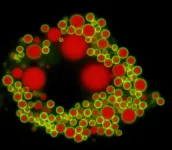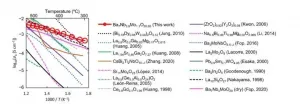Elusive 19th century Alaskan fort located using radar tech
2021-01-25
(Press-News.org) ITHACA, N.Y. - Researchers from Cornell University and the National Park Service have pinpointed and confirmed the location of the remnants of a wooden fort in Alaska - the Tlingit people's last physical bulwark against Russian colonization forces in 1804 - by using geophysical imaging techniques and ground-penetrating radar.
The fort was the last physical barrier to fall before Russia's six-decade occupation of Alaska, which ended when the United States purchased Alaska in 1867 for $7 million.
The Tlingit built what they called Shiskinoow - the "sapling fort" - on a peninsula in modern-day Sitka, Alaska, where the mouth of Kasda Heen (Indian River) meets Sitka Sound at the Sitka National Historical Park.
"The fort's definitive physical location had eluded investigators for a century," said co-author Thomas Urban, research scientist at Cornell. "Previous archaeological digs had found some suggestive clues, but they never really found conclusive evidence that tied these clues together."
To find Shiskinoow, Urban created a grid to see if the electromagnetic induction methods could spot the potential outline of the fort and then created a small grid for dragging the ground-penetrating radar. Urban's modern tools picked up the fort's unusual perimeter shape.
"We believe this survey has yielded the only convincing, multi-method evidence to date for the location of the sapling fort, which is a significant locus in New World colonial history and an important cultural symbol of Tlingit resistance to colonization," Urban said.
In 1799, Russia sent a small army to take over Alaska in order to develop the fur trade, but the Tlingit successfully expelled them in 1802. Expecting the Russians to return, the Tlingit built a wooden fort over two years - the trapezoidal-shaped Shiskinoow. The Tlingit armed it with guns, cannons and gunpowder obtained from British American traders.
When the Russians returned in 1804, the Tlingit held them off for five days, but suffered a setback when a gunpowder supply being carried to the fort from storage across Sitka Sound blew up in a canoe. The Tlingit clans escaped Shiskinoow by night across Shee (Baranov Island) to Cháatl ?áa Noow (Halibut Man Fort) and the Russians then established a trading post at what is now Sitka.
"A large-scale survey was necessary to convincingly rule out alternative locations for this historically and culturally significant structure," said co-author Brinnen Carter of the National Parks Service.
INFORMATION:
The research, "Geophysical Survey Locates an Elusive Tlingit Fort in Southeast Alaska," was published Jan. 25 in the journal Antiquity.
ELSE PRESS RELEASES FROM THIS DATE:
2021-01-25
During epileptic seizures, a large number of nerve cells in the brain fire excessively and in synchrony. This hyperactivity may lead to uncontrolled shaking of the body and involve periods of loss of consciousness. While about two thirds of patients respond to anti-epileptic medication, the remainder is refractory to medical treatment and shows drug-resistance. These patients are in urgent need for new therapeutic strategies.
Together with colleagues in Japan, Prof. Dr. Christine Rose and her doctoral student Jan Meyer from the Institute of Neurobiology at HHU have performed a study to address the cellular mechanisms that promote the development of epilepsy. While up to now, most studies and anti-epileptic drugs targeted nerve cells (neurons), ...
2021-01-25
Findings of a new study published by researchers from Trinity College Dublin and St James's Hospital outline the health impacts faced by older people while cocooning during the Covid-19 pandemic. The findings are published in the Quarterly Journal of Medicine here: https://bit.ly/3qGKJoI.
Cocooning involves staying at home and reducing face-to-face interaction with other people and is an important part of the response to the COVID-19 pandemic, with an overall aim to prevent transmission to vulnerable older people. However, concerns exist regarding the long-term adverse effects ...
2021-01-25
A new study from Indiana University researchers finds that most high-school age youth are willing to wear masks to help prevent the spread of the COVID-19 virus, but that more education is needed on how to wear masks properly and on the importance of consistent commitment to public health guidelines.
The study, published today in the Journal of Adolescent Health looked at 1,152 youth's mask wearing and social distancing behaviors during five, in-person live-streamed high school graduations from one U.S. public school district in early July 2020. These broadcasts allowed the researchers to systematically document social-distancing behaviors throughout the ceremonies and mask-wearing as students crossed the graduation stage ...
2021-01-25
Coconut oil has increasingly found its way into German kitchens in recent years, although its alleged health benefits are controversial. Scientists at the University of Bonn have now been able to show how it is metabolized in the liver. Their findings could also have implications for the treatment of certain diarrheal diseases. The results are published in the journal Molecular Metabolism.
Coconut oil differs from rapeseed or olive oil in the fatty acids it contains. Fatty acids consist of carbon atoms bonded together, usually 18 in number. In coconut oil, however, most of these chains are much shorter and contain only ...
2021-01-25
Research from North Carolina State University shows that extreme weather events, such as hurricanes and increased precipitation, affect both the amount and the composition of picophytoplankton in the Neuse River Estuary. The work is a first step in determining how a wetter climate may affect the estuarine ecosystem.
Picophytoplankton are defined as any phytoplankton measuring less than three micrometers in size. Although well studied as part of the oceanic ecosystem and food web, picophytoplankton are understudied in estuarine systems, even though they occur in significant numbers within these environments.
"Picophytoplankton are important primary producers in aquatic ecosystems," says Ryan Paerl, assistant professor of ...
2021-01-25
DALLAS - Jan. 25, 2021 - Small cell lung cancer (SCLC) cells are missing a surface protein that triggers an immune response, allowing them to hide from one of the body's key cancer defenses, a new study led by UT Southwestern researchers suggests. The findings, reported online today in Cancer Research, a journal of the American Association for Cancer Research, could lead to new treatments for SCLC, which has no effective therapies.
Despite decades of study, SCLC - a subset of lung cancer that makes up about 13 percent of lung cancer diagnoses - has a very poor prognosis, with only about 6 percent of patients surviving five years after ...
2021-01-25
Massive earthquakes are, fortunately, rare events. But that scarcity of information blinds us in some ways to their risks, especially when it comes to determining the risk for a specific location or structure.
"We haven't observed most of the possible events that could cause large damage," explained Kevin Milner, a computer scientist and seismology researcher at the Southern California Earthquake Center (SCEC) at the University of Southern California. "Using Southern California as an example, we haven't had a truly big earthquake since 1857 -- that was the last time the southern San Andreas broke into a massive magnitude ...
2021-01-25
Scientists at Tokyo Institute of Technology (Tokyo Tech), Imperial and High Energy Accelerator Research Organization (KEK) Institute of Materials Structure Science, discover new Ba7Nb4MoO20-based materials with high oxygen-ion (oxide-ion O2-) conductivities--"the hexagonal perovskite-related oxides"--and shed light on the underlying mechanisms responsible for their conductivity. Their findings lead the way to uncovering other similar materials, furthering research on developing low-cost and scalable renewable energy technologies.
Over the past few years, fuel cells have become a focal point of research in eco-friendly technology because of their ...
2021-01-25
Researchers from the Max Born Institute for Nonlinear Optics and Short Pulse Spectroscopy (MBI) have developed a new method to modify the spectral width of extreme-ultraviolet (XUV) light. By employing a novel phase-matching scheme in four-wave mixing, they could compress the spectral width of the initial broadband light by more than hundred times. The detailed experimental and theoretical results have been published in Nature Photonics.
Light, as emitted by the sun, consists of many different colors and typically appears as white. Sometimes, however, only certain colors reach our eyes, leading to stunning phenomena like an afterglow. For technical or scientific applications that require a specific color, gratings and prisms can be used to extract this color ...
2021-01-25
What The Study Did: The results of this study suggest that cumulative exposure to cigarette smoke is an independent risk factor for hospital admission and death from COVID-19.
Authors: Katherine E. Lowe, M.Sc., of the Cleveland Clinic Lerner College of Medicine of Case Western Reserve in Cleveland, is the corresponding author.
To access the embargoed study: Visit our For The Media website at this link https://media.jamanetwork.com/
(doi:10.1001/jamainternmed.2020.8360)
Editor's Note: The article includes conflicts of interest and funding/support disclosures. Please see the article for ...
LAST 30 PRESS RELEASES:
[Press-News.org] Elusive 19th century Alaskan fort located using radar tech






